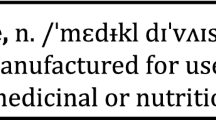Abstract
The Food and Drug Administration (FDA) decision process for approving or clearing medical devices is often determined by a review of robust clinical data and extensive preclinical testing of the device. The mission statement for the Center for Devices and Radiological Health (CDRH) is to review the information provided by manufacturers so that it can promote and protect the health of the public by ensuring the safety and effectiveness of medical devices deemed appropriate for human use (Food, Drug & Cosmetic Act, §903(b)(1, 2(C)), December 31, 2004; accessed December 17, 2008 http://www.fda.gov/opacom/laws/fdcact/fdctoc.htm). For high-risk devices, such as ventricular assist devices (VADs), mechanical heart valves, stents, cardiac resynchronization therapy (CRT) devices, pacemakers, and defibrillators, the determination is based on FDA’s review of extensive preclinical bench and animal testing followed by use of the device in a clinical trial in humans. These clinical trials allow the manufacturer to evaluate a device in the intended use population. FDA reviews the data from the clinical trial to determine if the device performed as predicted and the clinical benefits outweigh the risks. This article reviews the regulatory framework for different marketing applications related to cardiovascular devices and describes the process of obtaining approval to study a cardiovascular device in a U.S. clinical trial.
Similar content being viewed by others
References
Lloyd-Jones, D., Adams, R., Carenthon, M., et. al. (2009). Heart Disease and Stroke Statistics 2009. A Report from the American Heart Association Statistics Committee and Stroke Statistics Subcommittee. Circulation, 119:e1–e161.
Device Classification Panel. Accessed January 8, 2009. http://www.fda.gov/cdrh/devadvice/3131.html
Class I/II Exemptions. Accessed January 8, 2009. http://www.fda.gov/cdrh/devadvice/3133.html
Medical Device Exemptions 510(k) and GMP Requirements. Accessed January 8, 2009 http://www.accessdata.fda.gov/scripts/cdrh/cfdocs/cfpcd/315.cfm
“513(g)s”… Including 513(g) User Fees. Access January 16, 2009 http://fda.yorkmedia.com/fda/Viewer/Viewers/Viewer240TL.aspx?mode=Default&peid=c3f0f2dc-6244-4e07-aa5e-a7dbc954cea4&pid=ec37dbe8-2d36-4a59-91db-84fd06316973&playerType=WM7
IDE Guidance Staff. FDA Guidance Documents. January 20, 1998. Accessed December 17, 2008. http://www.fda.gov/cdrh/ode/idepolcy.pdf.
What is Substantial Equivalence. Accessed January 8, 2009 http://www.fda.gov/cdrh/devadvice/314.html#se
Good Laboratory Practice for Nonclinical Laboratory Studies, April 1, 2008. Accessed December 17, 2008. http://www.accessdata.fda.gov/scripts/cdrh/cfdocs/cfcfr/CFRSearch.cfm?CFRPart=58&showFR=1
Premarket Approval Application (PMA), April 1, 2008. Accessed December 17, 2008. http://www.accessdata.fda.gov/scripts/cdrh/cfdocs/cfcfr/CFRSearch.cfm?FR=814.20
Food, Drug & Cosmetic Act, §520(m), December 31, 2004. Accessed December 17, 2008. http://www.fda.gov/opacom/laws/fdcact/fdctoc.htm.
Author information
Authors and Affiliations
Corresponding author
Rights and permissions
About this article
Cite this article
Chen, E.A., Patel-Raman, S.M., O’Callaghan, K. et al. FDA’S Perspectives on Cardiovascular Devices. J. of Cardiovasc. Trans. Res. 2, 143–146 (2009). https://doi.org/10.1007/s12265-009-9096-7
Received:
Accepted:
Published:
Issue Date:
DOI: https://doi.org/10.1007/s12265-009-9096-7




